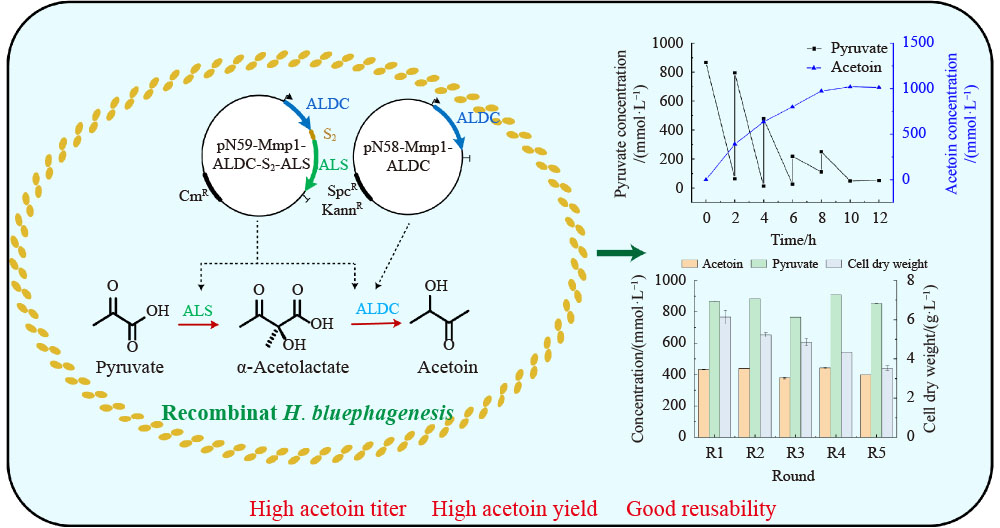Acetoin, also known as 3-hydroxybutanone, methyl acetyl methanol, is naturally existed in dairy products and some fruits with a special milk flavor, and is widely used in food, pharmaceuticals, chemical and other industries [
1–
3]. In 2004, it was listed as one of the 30 platform compounds for priority development and utilization by the Department of Energy of the United States [
4,
5]. Biological production of acetoin exhibits better potential compared with traditional chemical synthesis, such as higher product safety and less pollution to the environment [
3,
6,
7]. There are widely reported three strategies for biological acetoin production, which are microbial fermentation,
in vitro enzyme biocatalysis, whole-cell biocatalysis [
6]. A range of native and recombined microorganisms had been proved to produce acetoin efficiently, including
Bacillus subtilis [
8],
Serratia marcescens [
4],
Saccharomyces cerevisiae [
9],
Escherichia coli [
5], etc. According to the reports on acetoin production by microbial fermentation, a titer of 102.5 g·L
–1 acetoin was obtained from glucose with a yield of 0.419 g·g
–1 by a fed-batch strategy in 5 L bioreactor using engineered
Corynebacterium glutamicum [
10]. Besides, Bae et al. [
11] obtained 101.3 g·L
–1 of (
R)-acetoin with high yield from glucose in rich yeast peptone dextrose medium by engineered
S. cerevisiae. Glycerol was also used for acetoin production. Almuharef et al. [
12] used the strain SRWQ1 to produce a significant amount of acetoin (8.38 ± 0.76 g·L
–1) with a yield of 0.06 g·g
–1 from glycerol. A wide range of substrates and host bacteria were used in microbial fermentation for acetoin production but the titer of acetoin was hard to further elevate after it reached 100 g·L
–1. As for
in vitro enzyme biocatalysis, it had a complex enzyme extraction and purification process, which greatly increased the complexity and cost of the bioconversion process, thus this method was not much conducive to industrial application. Compared with these two approaches, whole-cell biocatalysis had the advantages of eliminating the complex enzyme extraction and purification steps as well as maintaining the activity and stability of intracellular enzymes. Therefore, a lot of chemicals with high-value had been produced by whole cell biocatalysis [
13,
14] and researches on the production of acetoin by whole-cell biocatalysis had attracted a lot of interest. At present, acetoin with high yield was mainly synthesized from 2,3-butanediol or acetaldehyde. Yamada-Onodera et al. [
15] constructed a recombinant
E. coli HB101 overexpressing glycerol dehydrogenase, which could produce acetoin from 2,3-butanediol with a high enantionmeric excess (
ee) value of over 99.9%. A new biocatalysis of
E. coli/pET-
mbdh-
nox-
vgb was explored that could synthesize chiral (3
R)-acetoin from
meso-2,3-butanediol. Under optimized conditions, 86.74 g·L
–1 of (3
R)-acetoin was achieved from 93.73 g·L
–1 meso-2,3-butanediol with a yield of 0.925 g·g
–1, a productivity of 3.61 g·L
–1·h
–1 and an
ee value of 95.78% [
5]. Bao et al. [
16] proposed a strategy of constructing an NAD
+ (nicotinamide adenine dinucleotide) regeneration system for efficiently converting 2,3-butanediol to acetoin by using engineered
B. subtilis as whole-cell biocatalysis and efficiently produced 91.8 g·L
–1 of acetoin with a yield and productivity of 0.765 g·g
–1 and 2.3 g·L
–1·h
–1, respectively. In addition, Zhou et al. [
17] used
Gluconobacter oxydans NL71 for bio-oxidization of 2,3-butanediol to acetoin and 165.9 g·L
–1 of acetoin was obtained with a yield and productivity of 0.932 g·g
–1 and 11.43 g·L
–1·h
–1 respectively in 36 h. The highest titer (222 g·L
–1) of acetoin was produced from acetaldehyde by an
E. coli whole-cell biocatalytic system [
18]. However, both 2,3-butanediol and acetaldehyde are mainly coming from non-renewable fossil resources, the use of fossil fuels might cause the aggravation of environmental pollution and the shortage of fossil resources [
3]. Moreover, 2,3-butanediol and acetaldehyde are relative expensive compared to other substrates such as pyruvate and lactate. It is crucial to find a cheap and renewable substrate to produce acetoin efficiently.










